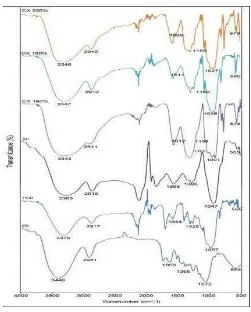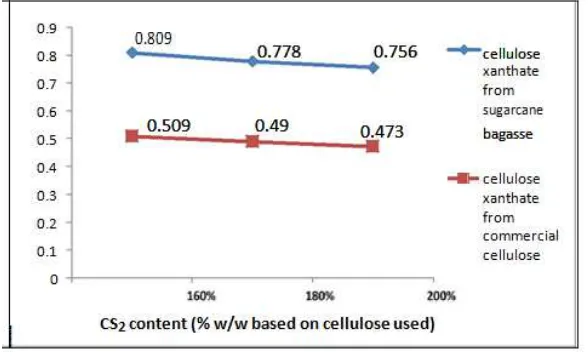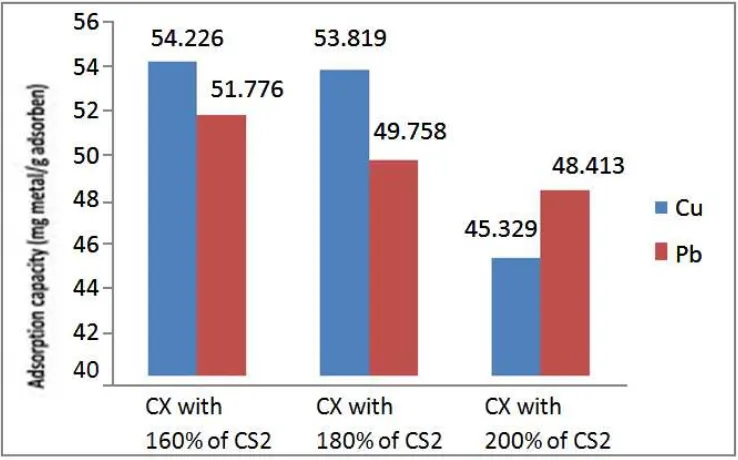IOP Conference Series: Earth and Environmental Science
PAPER • OPEN ACCESS
Preparation and evaluation adsorption capacity of
cellulose xanthate of sugarcane bagasse for
removal heavy metal ion from aqueous solutions
To cite this article: D A Iryani et al 2017 IOP Conf. Ser.: Earth Environ. Sci.65 012039
View the article online for updates and enhancements.
Related content
Adsorption of Lead ions onto Activated Carbon derived from Sugarcane bagasse I. U Salihi, S.R.M Kutty and M. H Isa
-Preparation and characterization of activated carbon from sugarcane bagasse by physical activation with CO2 gas Sutrisno Bachrun, Noni AyuRizka, SolichaHidayat Annisa et al.
-Nanostructured polyaniline rice husk composite as adsorption materials synthesized by different methods Thi Tot Pham, Thi Thanh Thuy Mai, Minh Quy Bui et al.
Preparation and evaluation adsorption capacity of
cellulose xanthate of sugarcane bagasse for removal
heavy metal ion from aqueous solutions
D A Iryani
1,4, N M Risthy
1, D A Resagian
1, S D Yuwono
2,4,
U
Hasanudin
3,41Department of Chemical Engineering, Engineering Faculty, University of Lampung,
Lampung, Indonesia.
2Department of Chemistry, Mathemathic and Science Faculty, University of
Lampung, Lampung, Indonesia
3Department of Agroindustrial Technology, Agriculture Faculty, University of
Lampung, Lampung, Indonesia
4 Research and Development Center for Tropical Biomass, University of Lampung, Lampung Indonesia divalent metal ions. Cellulose xanthate is one of the selective adsorbent to solve this problem, since xanthate contains two negative sulfur atoms that is capable to catch divalent metal ions. Preparation of cellulose xanthate was conducted by reacting carbon disulfide (CS2) and cellulose from sugarcane bagasse. The morphological characteristics of cellulose xanthate were visualized via Scanning Electron Microscope (SEM) and the presence of sulfur groups on sugarcane bagasse xanthate were identified by FTIR spectroscopic study. The degree of substitution (DS), degree of polymerization (DP), and adsorption capacities of cellulose xanthate for Cu2+ and Pb2+ metal were studied. The results of study reveals that the maximum adsorption capacities of Cu2+ and Pb2+ metal on cellulose xanthate are 54.226 mg Cu2+/g, and 51.776 mg Pb2+/g, respectively. This study reveals that cellulose xanthate could be a solution to reduce environmental pollution caused by industrial wastewater.
1. Introduction
2
1234567890
International Conference on Biomass: Technology, Application, and Sustainable Development IOP Publishing IOP Conf. Series: Earth and Environmental Science 65 (2017) 012039 doi :10.1088/1755-1315/65/1/012039
damage, metabolic disorders, and death. Toxicity in small doses can cause neurotoxic (neurotoxin) and abnormal behavior[3].
There are many methods for removal of heavy metals ion from aqueous solutions. The most simple and effective technique for removal of heavy metals ion from aqueous solutions is adsorption process, and ion-exchange are very often used in adsorption processes[4]. Nowadays, there has been considerable interest in the use of agricultural by-products as an adsorbents to solve this problem due to have some advantages include relative cheapness, renewability, high adsorption capacity, and abundance in nature especially in Lampung Province. Lampung is one of the provinces with abundant sugarcane bagasse resources[5]. Sugarcane bagasse is the by-product of sugar industry, which is constituted of cellulose, lignin and hemicellulose. Since sugarcane bagasse contains a large amount of hydroxyl groups in the structure[6], its absorption capability can be improved by chemical modification[7].
The purpose of this study was to modify sugarcane bagasse with carbon disulfide (CS2) to enhance its
adsorption properties for the removal of Cu2+ and Pb2+ from aqueous solutions. Sugarcane bagasse can uses as an adsorbent of heavy metal waste by converting it to cellulose xanthate. Cellulose xanthate is a reaction product of cellulose with carbon disulfide (CS2) that forms a salt with the
chemical formula ROCS2-M+ (R = alkyl; M+ = Na+)[8]. Basically, xanthate contains two negative
sulfur atom that is capable to catch divalent metal ions such as Cu2+, Pb2+, and others[9]. Effect of concentrations of CS2 in cellulose xanthate synthesis was studied. The morphological characteristics
of cellulose xanthate were visualized via Scanning Electron Microscope (SEM) and the functional groups present in the adsorbent were characterized by a Fourier Transform Infrared (FTIR) spectrophotometer. The degree of substitution (DS), degree of polymerization (DP), and adsorption capacities of cellulose xanthate (CX) for Cu2+ and Pb2+ metal were also studied.
2. Material and Methods
2.1 Chemicals
All chemicals Purchased from Merck were NaOH, carbon disulfide (CS2), HNO3, H2SO4, BaCl2,
distilled water and heavy metal solutions PbSO4 and CuSO4.
2.2 Sugarcane Bagasse Purification
Sugarcane bagasse (SB) provided from PT. Gula Putih Mataram (GPM) – Central Lampung was ground using a cutting mill to form powder with a maximum particle size of 1.0-1.5 mm, washed and dried in an oven at 105 °C for 3 h before purification treatment. Purification treatment method was adopted from Cerqueira et al.[10]. About 150 g of sugarcane bagasse were treated by soaking in 750 mL of NaOH 0.25 M for 18 hours at room temperature and continued in 750 mL of HNO3 20% (v/v)
for 3 hours at room temperature. After the treatments the purified sugarcane bagasse (PSB) was filtered and washed with distilled water, then dried at 105°C for 3 hours.
2.3 Synthesis Cellulose Xanthate
About 15 g of PSB was soaked in 100 mL of 18% NaOH solution and stirred for 3 hours at room temperature[11]. About 160, 180, 200% of CS2 (w/w) by the amount of cellulose used was added to
the mixture. It means about 24 g (19.2 mL) of CS2 was used on the CS2 concentration of 160%, 27 g
(21.6 mL) of CS2 on the CS2 concentration of 180%, and 30 g (24 mL) of CS2 on the CS2
concentration of 200%. After CS2 was added to the mixture, the reaction was continued for 100
excess alkali, and then the sample was dried at 105°C for 3 hours and stored at low temperature (5-8°C)[12].
2.4. Biosorption Experiments And Analysis
All of the adsorption tests carried out by the batch technique. About 0.1 g of adsorbent was put into a 100 mL conical flask together with a 100 mL single metal ion (Cu2+ or Pb 2+) solution with pH range
2.0-6.5. The concentration of metal ion solution was 100 mg/L. The mixture was shaken at 120 rpm on a shaker for 2 hours[12]. The residual metal ion concentrations in the supernatant liquor were determined by using an Atomic Absorption Spectrophotometer (AAS), the amount of metal adsorbed (Q) were determined by using the following equations:
Q =𝑉 (𝐶0−𝐶𝑎)𝑚 (1)
Where Co (mg/L) and Ca (mg/L) are the initial and final metal ions concentrations, respectively. V (L) is the volume of solution, and m (g) is the weight of cellulose xanthate (adsorbent)[12].
2.5. Determination of degree of substitution (DS)
The degree of substitution is the ratio between the number of xanthate groups per cellulose unit in the cellulose xanthate compound. Before calculating the value of DS, the ratio of sulfur to cellulose ((% sulfur)/(% cellulose)) has to be determined first. Amount of sulfur in the cellulose xanthate was determined by using gravimetric methods[13], whereas amount of cellulose in the cellulose xanthate was determined by using gravimetric methods[14]. The ratio of sulfur to the cellulose of 0.395, stating there is one xanthate group per cellulose unit in the cellulose xanthate.
Sulfure
Thus, the value of DS can be determined by using the following equation[15]:
DS =ratio of sulfure to glucose0.395 (3)
2.6. Determination of degree of polymerization (DP)
The degree of polymerization can be calculated by comparing the molecular weight of cellulose xanthate (CX) to the molecular weight of structural unit[16]:
DP =Molecular weight of structural unitMolecular weight of CX (4)
The molecular weight of cellulose xanthate can be determined with the viscosity methods by using Viscometer Ostwald. This methods has been conducted by Agnemo[17]. Molecular weight of cellulose xanthate was calculated by using Mark Houwink equations:
[ƞ] = K.Ma
[ƞ] = viscosity of cellulose xanthate
M = Molecular weight of cellulose xanthate.
4
1234567890
International Conference on Biomass: Technology, Application, and Sustainable Development IOP Publishing IOP Conf. Series: Earth and Environmental Science 65 (2017) 012039 doi :10.1088/1755-1315/65/1/012039
3. Results and Discussion
3.1 Characterization of the Adsorbent
Cellulose xanthate was synthesized by reacting cellulose with an amount of carbon disulfide (CS2) in
NaOH solution. In this study, cellulose xanthate was synthesized by reacting purified sugarcane bagasse (PSB) with 160, 180, and 200% of CS2 (w/w, by the amount of PSB used) in NaOH solution
(18%). figure 1 shows the hydroxyl groups on the cellulose backbone combined with CS2 in the
xanthation process.
Figure 1. Scheme of cellulose xanthate synthesis[18]
The FTIR spectra of sugarcane bagasse (SB), purified sugarcane bagasse (PSB), alkalized cellulose (AC) and cellulose xanthate (CX) were carried out as a qualitative analysis to determine the main functional groups present in the adsorbent. FTIR spectra of SB, PSB, AC, and CX are shown in figure 2. In the spectrum of SB and PSB the peaks around 3,450 cm-1 correspond to the hydroxyl groups stretching vibrations. The peaks observed around 1,070 cm-1 are due to the C-O stretching vibrations that is attributed to the characteristic of carboxylic acids and alcohols. The peaks around 1,650 cm-1 can be assigned to bending vibration of the C=C group. The peaks at 2,900 cm-1 is stretching vibrations of C-H group[12]. There is a new peak at 1,208 cm-1 in the spectrum of AC that is
Figure 2. FTIR spectra of SB, PSB, AC, and CX
The SEM of purified sugarcane bagasse (PSB) and cellulose xanthate (CX) were carried out as a qualitative analysis to describe the morphological characteristics of adsorbent. The morphology of PSB and CX are shown in figure 3 and figure 4. Figure 3 shows the disorder pattern and rough surface of the cellulose structure in the PSB. Figure 4 shows that the cellulose structure is finer and has uniform pattern in the SEM of CX. The changing of morphology of PSB due to the fibrous was liberated from the matrix caused alkalization process. Additionally, alkalization process (soaking treatment of NaOH) could make the structure of cellulose expand and increase the porosity and specific surface area. This structure is needed to makes CS2 react easily with cellulose to form
cellulose xanthate in the xanthation process[8], and could improve the adsorption capacity of adsorbent for heavy metal ions in aqueous solution[12].
6
1234567890
International Conference on Biomass: Technology, Application, and Sustainable Development IOP Publishing IOP Conf. Series: Earth and Environmental Science 65 (2017) 012039 doi :10.1088/1755-1315/65/1/012039
The degree of substitution (DS) and degree of polymerization (DP) of cellulose xanthate (CX) were also carried out as a quantitative analysis. DS represents the number of xanthate groups per cellulose unit in the CX compound, whereas DP represents the amount of structural unit in the CX.
Figure 5. DS of cellulose xanthate
Figure 5 and figure 6 shows the effects of CS2 content used in CX synthesis to the value of DS and
DP. The CX made with 160% of CS2 showed higher value of DS and DP. The highest value of DS are
0.809 for CX from sugarcane baggase and 0.509 for CX from commercial cellulose, whereas the higher value of DP is 325.757. If CS2 content was higher than 160%, the value DS and DP was
decreased. However, the reason for the decreasing value of DS and DP at higher CS2 content is not
clear. We speculate if CS2 content was too higher in xanthation process, the trend of side reaction
between CS2 and sodium hydroxide become higher. Another speculation is some CS2 molecules might
be adsorbed physically on the hydrocarbon backbone if using an excess amount of CS2 in CX
synthesis[19].
3.2 Adsorption Capacity
There are some important parameters affecting the adsorption process such as pH, temperature, etc. pH range of aqueous solution are from 2.0 to 6.5 on adsorption of Cu2+ and Pb2+ at room temperature for 120 min. 0.1 g of adsorbent was taken into a 100 mL conical flask together with a 100 mL single metal ion (Cu2+ or Pb2+) solution [12]. The concentration of metal ion solution was 100 mg/L. The mixture was shaken at 120 rpm on a shaker for 2 hours. The residual metal ion concentrations in the supernatant liquor were determined by using an Atomic Absorption Spectrophotometer (AAS). Adsorption capacities of cellulose xanthate for Cu2+ and Pb2+ metal are shown in figure 7.
Figure 7. Adsorption capacity of cellulose xanthate
Adsorption capacity of cellulose xanthate decreases when CS2 content in xanthation process was
higher. This trend is similar to the trend of DS and DP of cellulose xanthate. Cellulose xanthate made with 160% of CS2 showed higher adsorption capacities of Cu2+ and Pb2+ metal, that are 54.226 mg/g
and 51.776 mg/g, respectively. This trend was also observed in experiments of Kim and Lee[19] with Pb2+ under pH 6.5. According to the experiments of Kim and Lee[19], by using more than 14 mL of CS2 in the cellulose xanthate synthesis, lead removal was decreased. It reveals that an excess amount
of CS2 in the cellulose xanthate synthesis decreases the value of DS, DP, and adsorption capacity.
4. Conclusions
Cellulose xanthate was synthesized by reacting cellulose of sugarcane bagasse with an amount of carbon disulfide (CS2) then to be used as an adsorbent for the removal Cu2+ and Pb2+ from aqueous
solution. FTIR spectra showed the presence of the sulfur groups in the cellulose xanthate. The SEM were carried out to describe the morphological characteristics of adsorbent. The morphological of cellulose xanthate indicated the finer, expands, and uniform pattern of cellulose structure, which could increase the porosity, specific surface area, and improve the adsorption capacity of adsorbent for heavy metal ions in aqueous solution. The degree of substitution (DS), degree of polymerization, and adsorption capacity of cellulose xanthate decreased when CS2 content was higher than 160% in
8
1234567890
International Conference on Biomass: Technology, Application, and Sustainable Development IOP Publishing IOP Conf. Series: Earth and Environmental Science 65 (2017) 012039 doi :10.1088/1755-1315/65/1/012039
value of DS, DP, and adsorption capacities of Cu2+ and Pb2+ metal. The highest DS and DP of cellulose xanthate from sugarcane bagasse are 0.809 and 325.757, whereas the highest adsorption capacities of cellulose xanthate for Cu2+ and Pb2+ metal are 54.226 mg/g and 51.776 mg/g,
respectively. This study reveals that sugarcane bagasse modified with carbon disulfide (CS2) is a
promising biosorbent for the removal of heavy metals and could be a solution to reduce environmental pollution caused by industrial wastewater.
References
[1] Argun M and Dursun S 2008 A new approach to modification of natural adsorbent for heavy metal adsorption Bioresour. Technol.99 2516-2527
[2] Liang S, Guo X, Feng N, Tian Q 2010 Enhanced Cu (III) adsorption by orange pell modified with sodium hydroxide Journal of Elsevier. Trans. Nonferrous Met. Soc. China20 s187-s191. [3] Darmono 1995 Logam dalam Sistem Biologi Mahluk Hidup (Jakarta: UI Press)
[4] Wang S and Peng Y 2010 Natural zeolites as effective adsorbents in water and chemical production International Journal of Green Energy. 11 577-588
[7] Vaughan T, Seo C, Marshall W 2001 Removal of As (V) from aqueos solutions by waste crab shell Bioresour. Technol. 78 133
[8] Heuser E 1943 The Chemistry of Cellulose (London: John Wiley & Song INC)
[9] Riwayati I, Hartati I, Purwanto H, Suwardiyono 2014 Adsorsi logam berat Timbal dan Kadmiun pada limbah batik menggunakan pulpa kopi terxanthasi Prosiding Seminar Nasional Aplikasi Sains &Teknologi 15th November 2014 Yogykarta Indonesia.
[10] Cerqueira D, Filho G and Meireles C 2007 Optimization of sugarcane bagasse acetylation
CarbohydratePolymers 69 579-582
[11] Gilbert R 1994 Cellulose Polymers, Blends, and Composites (Germany: Hanser Publications)
[12] Tian A, Jiang X, Yu H, Pan D and Liu Q 2015 Equilibrium, kinetic and mechanism studies on the biosorption of Cu2+ and Ni
2+ by sulfur-modified bamboo powder Korean Journal Chem. Eng.32 342-349
[13] SNI (Standar Nasional Indonesia) 2004 Prosedur analisa sulfat dengan metode gravimetri 06-6989.20-2004
[14] Sluiter A, Hames B, Ruiz R, Scarlata C, Sluiter J, Templeton D and Crocker D 2005 Determination of structural carbohydrates and lignin in biomass. The US National Renewable Energy LaboratoryTechnical Report (US: NREL)
[15] Vincent D 1953 Xanthate methyl esters of simple alcohols and of cellulose Thesis for The Degreeof Doctor of Philosophy (Canada: McGill University)
[16] Habibah R, Nasution D, Muis Y 2013 P b k d d j d p α-selulosa yang berasal dari alang-alang ((Imperata cylindrica) dengan metode viskositas Jurnal Saintia Kimia1
[17] Agnemo R 2009 Methods to analyze cellulose pulps for viscose production Paper presented at 4 Workshop on Cellulose, Regenerated Cellulose and Cellulose Derivates (Sweden: Karstald University)
[18] Homagai P, Ghimire K and Inoue K 2010 Preparation and characterization of charred xanthated sugarcane bagasse for the separation of heavy metals from aqueous solutions Separation Science andTechnology46 330-339
![Figure 1. Scheme of cellulose xanthate synthesis[18]](https://thumb-ap.123doks.com/thumbv2/123dok/3993234.1936654/5.595.97.502.237.326/figure-scheme-of-cellulose-xanthate-synthesis.webp)


